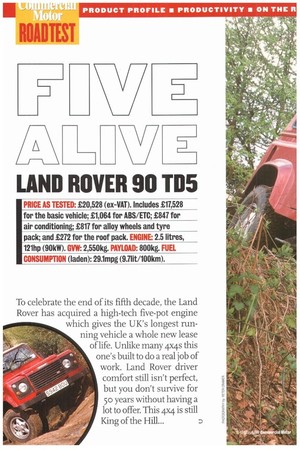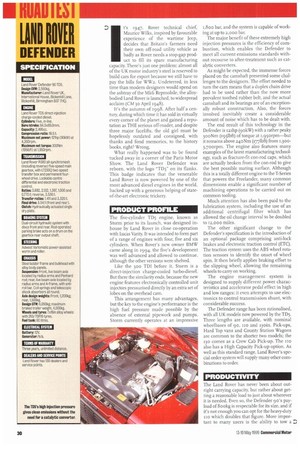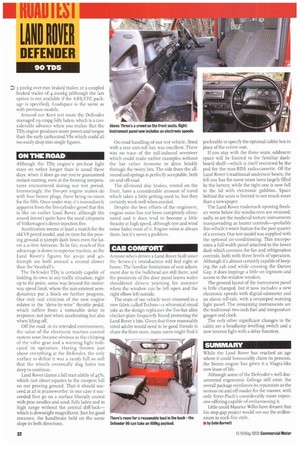LAND ROVER 90 TD5
Page 30

Page 32

Page 34

If you've noticed an error in this article please click here to report it so we can fix it.
'PRICE AS TESTED: £20,528 (ex-VAT). Includes £17,528 for the basic vehicle; £1,064 for ABS/ETC; £847 for air conditioning; £817 for alloy wheels and tyre pack; and .1272 for the roof pack. ENGINE: 15 litres, 121hp (90kW). OW: 2,550kg. PAYLOAD: sookg. FUEL CONSUMPTION (laden): 291mpg (9.711t/100km).
To celebrate the end of its fifth decade, the Land Rover has acquired a high-tech five-pot engine which gives the UK's longest running vehicle a whole new lease of life. Unlike many 4ms this one's built to do a real job of work. Land Rover driver comfort still isn't perfect, but you don't survive for 50 years without having a lot to offer. This 4x4 is still King of the Hill... t's 1947. Rover technical chief, Maurice Wilks, inspired by favourable experience of the wartime Jeep, decides that Britain's farmers need their own off-road utility vehicle as badly as Rover needs a stop-gap product to fill its spare manufacturing capacity. There's just one problem: almost all of the UK motor industry's steel is reserved to build cars for export because we still have to pay the bills for WW2. Undeterred, in less time than modem designers would spend on the ashtray of the Mk6 Repmobile, the alloybodied Land Rover is launched, to widespread acclaim (CM 30 April 1948).
It's the autumn of 1998. After half a century, during which time it has sold in virtually every corner of the planet and gained a reputation as THE serious off-roader, and despite three major facelifts, the old girl must be hopelessly outdated and consigned, with thanks and fond memories, to the history books, right? Wrong.
What really happened was to be found tucked away in a corner of the Paris Motor Show. The Land Rover Defender was reborn, with the logo "TD5" on its flanks. This badge indicates that the venerable Land Rover is now powered by one of the most advanced diesel engines in the world, backed up with a generous helping of stateof-the-art electronic trickery.
PRODUCT PROFILE
The five-cylinder TD5 engine, known as Storm prior to its launch, was designed inhouse by Land Rover in close co-operation with Lucas Varity. It was intended to form part of a range of engines with four, five and six cylinders. When Rover's new owner BMW came along in 1994, the five's development was well advanced and allowed to continue, although the other versions were shelved.
Like the 300 TDI before it, Storm is a direct-injection charge-cooled turbo-diesel. But there the similarity ends, because the new engine features electronically controlled unit injectors pressurised directly by an extra set of lobes on the overhead cam.
This arrangement has many advantages, but the key to the engine's performance is the high fuel pressure made possible by the absence of external pipework and pumps. Storm currently operates at an impressive 1,800 bar, and the system is capable of working at up to 2,000 bar.
The major benefit of these extremely high injection pressures is the efficiency of cornbustion , which enables the Defender to meet all current emissions standards without recourse to after-treatment such as catalytic converters.
As might be expected, the immense forces placed on the camshaft presented some challenges to the designers. The effort needed to turn the cam means that a duplex chain drive had to be used rather than the now more prevalent toothed rubber belt, and the actual camshaft and its bearings are of an exceptionally robust construction. Also, the forces involved inevitably create a considerable amount of noise which has to be dealt with.
The end result of this technology in the Defender is izihp (9okW) with a rather peaky 300Nm (1951bft) of torque at 1,95orpm—but it remains above 24oNm (1771bft) from 1,3003,7oorpm. The engine also features many examples of the latest manufacturing technology, such as fracture-fit con-rod caps, which are actually broken from the con-rod to give the best possible mating surface. Although this is a totally different engine to the TSeries that powers the Freelander, many common dimensions enable a significant number of machining operations to be carried out on common tooling.
Much attention has also been paid to the lubrication system, including the use of an additional centrifugal filter which has allowed the oil change interval to be doubled to 12,000 miles.
The other significant change to the Defender's specification is the introduction of an optional package comprising anti-lock brakes and electronic traction control (ETC). The traction system uses the ABS wheel rotation sensors to identify the onset of wheel spin. It then briefly applies braking effort to the slipping wheel, allowing the remaining wheels to carry on working.
The engine management system is designed to supply different power characteristics and accelerator pedal effect in high and low ranges: it even attempts to use electronics to control transmission shunt, with considerable success.
The Defender range has been rationalised, with all UK models now powered by the TD5. Three lengths are available, with nominal wheelbases of 90, Ito and 13oin. Pick-ups, Hard Top vans and County Station Wagons are common to the shorter two models; the 130 comes as a Crew Cab Pick-up. The Ho also has a High Capacity Pick-up option. As well as this standard range, Land Rover's special order system will supply many other cornbinations to order.
PRODUCTIVITY
The Land Rover has never been about outright carrying capacity, but rather about getting a reasonable load to just about wherever it is needed. Even so, the Defender 90's payload of 800kg is respectable for its size, and if it's not enough you can opt for the heavy-duty HO which doubles that figure. More important to many users is the ability to tow a 3,50 okg over-run braked trailer, or a coupled braked trailer of 4,000kg (although the last option is not available if the ABS/FTC package is specified). Loadspace is the same as with previous models.
Around our Kent test route the Defender managed 29.mipg fully laden, which is a considerable advance when you realise that the TD5 engine produces more power and torque than the early carburated V8s which could all too easily drop into single figures.
ON THE ROAD
Although the TD5 engine's pre-heat light stays on rather longer than is usual these days, when it does go out you're guaranteed instant starting, even at the freezing temperatures encountered during our test period. Interestingly, the five-pot engine makes do with four heater plugs, there being no room for the fifth. Once under way, it's immediately appareni from the five-cylinder growl that this is like no earlier Land Rover, although the sound doesn't quite have the aural crispness of Volkswagen's direct-injection five.
Acceleration seems at least a match for the old V8 petrol model, and its time for the proving ground o-5omph dash beats even the latest 2.o-litre Astravan. To be fair, much of this advantage is down to superior traction, as the Land Rover's figures for 30-50 and 406omph are both around a second slower than the Vauxhall's.
The Defender TD 5 is certainly capable of holding its own in any traffic situation, right up to the point, some way beyond the motorway speed limit, where the non-existent aerodynamics put a block on further progress. Our only real criticism of the new engine relates to the "drive-by-wire" throttle pedal, which suffers from a noticeable delay in response, not just when accelerating but also when lifting off Off the road, in its intended environment, the value of the electronic traction control system soon became obvious as the chirping of the valve gear and a warning light indicated its operation. Having thrown just about everything at the Defender, the only surface to defeat it was a sandy hill so soft that the wheels eventually dug holes too deep to continue.
Land Rover claims a hill start ability of 45%, which just about equates to the steepest hill on our proving ground. That it should succeed at all is praiseworthy: in our case it succeeded first go on a surface liberally coated with pine needles and sand, frilly laden and in high range without the central diff-lockwhich is downright magnificent. Just for good measure, the handbrake held on the same slope in both directions.
On-road handling of our test vehicle, fitted with a rear anti-roll bar, was excellent. There was no trace of the roll-induced oversteer which could make earlier examples without the bar rather tiresome to drive briskly through the twisty bits. The ride from the allround coil springs is perfectly acceptable, both on and off-road.
The all-round disc brakes, vented on the front, have a considerable amount of travel which takes a little getting used to, but they certainly work well when needed.
Despite the best efforts of the engineers, engine noise has not been completely eliminated and it does tend to become a little thrashy at high speed, although tyre and wind noise hides most of it. Engine noise is always there, but it's never a problem.
CAB COMFORT
Anyone who's driven a Land Rover built since the Series-3's introduction will feel right at home. The familiar limitations of seat adjustment due to the bulkhead are still there, and the proximity of the door panel leaves wider shouldered drivers yearning for summer when the window can be left open and the right elbow left outside.
The seats of our vehicle were trimmed in a new fabric called Techno—a whimsical visual joke as the design replicates the five-bar alloy checker-plate frequently found protecting the Land Rover's bits. Given that three reasonably sized adults would need to be good friends to share the front seats, many users might find it preferable to specify the optional cubby box in place of the centre seat.
If you stay with the three seats, oddment space will be limited to the familiar dashboard shelf—which is itself restricted by the pod for the non-RDS radio-cassette. Of the Land Rover's traditional underseat boxes, the left one has for some years been largely filled by the battery, while the right one is now full to the lid with electronic g,ubbins. Space behind the seats is limited to not much more than a newspaper.
The Land Rover trademark opening freshai r vents below the windscreen are retained: sadly, so are the medieval torture instruments masquerading as heater controls—probably this vehicle's worst feature for the past quarter of a century. Our test model was supplied with the optional air-conditioning. This incorporates a full-width panel attached to the lower dash which contains the fan and refrigeration controls, both with three levels of operation. Although it's almost certainly capable of keeping the cab cool while crossing the Darien Gap, it does impinge a little on legroom and access to the window winders, The general layout of the instrument panel is little changed, but it now includes a new electronic speedo with digital odometer and an alarm tell-tale, with a revamped warning light panel. The remaining instruments arc the traditional two-inch fuel and temperature gauges and clock.
The only other significant changes to the cabin are a headlamp levelling switch and a new interior light with a delay function.
SUMMARY
While the Land Rover has reached an age where it could honourably claim its pension, the Storm engine has given it a Viagra-like new lease of life.
Although some of the Defender's well documented ergonomic failings still exist, the overall package reinforces its reputation as the serious on and off-roader for the masses, with only Steyr-Puch's considerably more expensive offering capable of embarrassing it.
Little could Maurice Wilks have dreamt that his stop-gap project would see out the millennium in such fine style.
• by Colin Barnett
SPECIFICATION
MODEL
Land Rover Defender 90 TD5. Design Mit 2,550kg. Manufacturer Land Rover UK, international House, Flickenhill Lane, Bickenhill, Birmingham 837 7HQ.
ENGINE
Land Rover TD5 direct-injection charge-cooled diesel. Cylinders: Five, in-line. Bore/stroke: 84.5x89.0mm. Capacity: 2,495cc.
Compression ratio: 19,5:1.
Maximum net power:121hp (90kW) at 4,20Orpm,
Maximum net torque: 300Nm (195Ibft) at 1,950rpm.
TRANSMISSION
Land Rover R3B0 all-synchromesh (including reverse) five-speed main gearbox, with LT230Q two-speed transfer box and permanent fourwheel drive. Lockable centre differential and electronic traction control.
Min 3692, 2332,1.397, 1.000 and 0.770:1; reverse, 3.536:1.
tamsfer ratlot L411and 3.320:1. Rnal drIvw 3.54:1 (front and rear). Glut* Hydraulically actuated single dry plate.
BRAKING SYSTEM
Dual-circuit hydraulic system with discs front and rear. Rod-operated parking brake acts on a drum on the gearbox rear output shaft.
STEERING
Adwest Variomatic power-assisted worm and roller.
CHASSIS
Steel ladder frame and bulkhead with alloy body panels.
Suspension: Front, live beam axle located by radius arms and Panhard rod; rear, live beam axle located by radius arms and A-frame, with antiroll bar. Coil springs and telescopic shock absorbers all round.
Axle design weights: Front, 1,200kg; rear,t5ookg.
Design GTW: 6,050kg; maximum braked trailer weight, 4,000kg. Wheels and tyres: 7x16in alloy wheels with 265/75R16 tyres.
Fuel tank: 60 litres.
ELECTRICAL SYSTEM
Battery:12V. Generator Fa
TERMS OF WARRANTY
Three years, unlimited distance.
DEALERS AND SERVICE POINTS Land Rover has 130 dealers and service points.
The TD5's high injection pressure gives clean emissions without the need for a catalytic converter.
















































































































